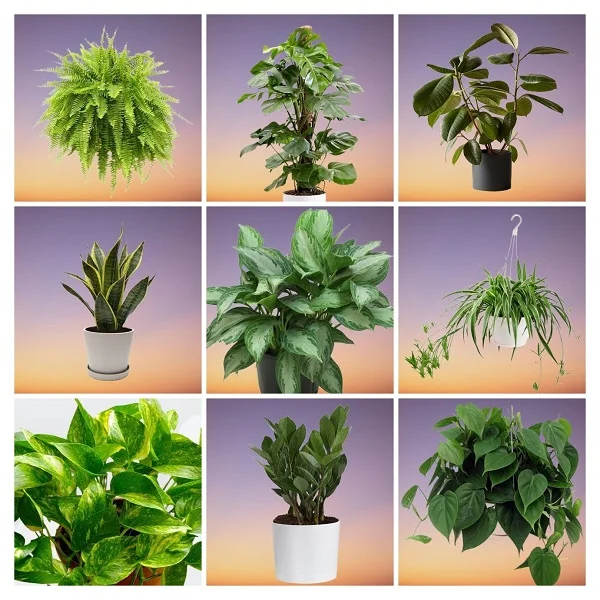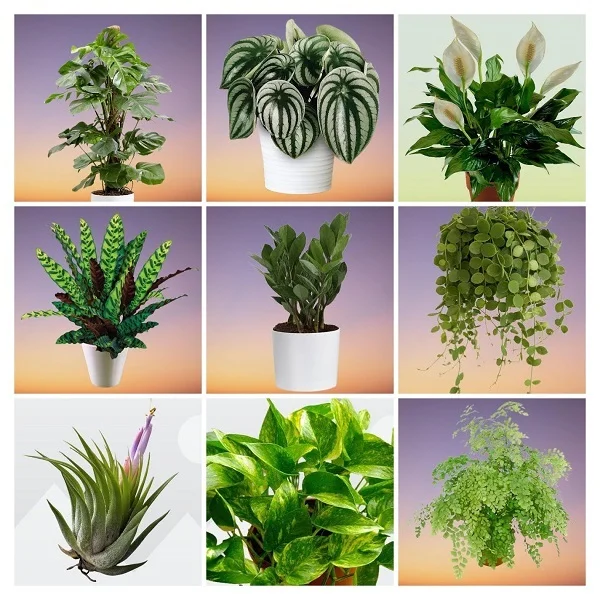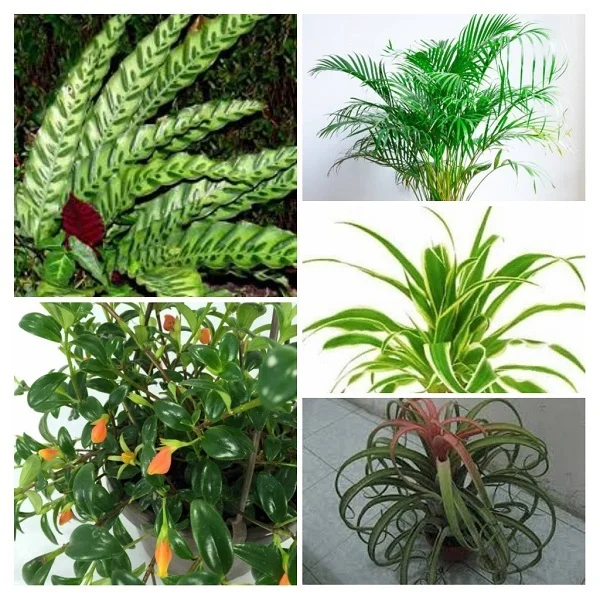Hedera helix (English Ivy) Care Indoors, Common Problems and Remedies
Some links in this post may be affiliate links
Hedera helix (English Ivy) grows best in bright indirect light, average warmth, moderate humidity and moderately moist, fertile, well-drained soils coupled with monthly feeding in the growing season.
Hedera helix is a classic trailing plant prized for its evergreen foliage, elegant cascading vines, and air-purifying properties. This guide covers everything you need to know about growing, caring, and troubleshooting English Ivy indoors.
English Ivy also called Common Ivy or European Ivy is one of the best plants for hanging baskets. It can also be grown as a climber on a trellis as a screen or in covering unattractive spots in the home or office.
Hedera helix grows slowly in the first 2 years of establishment. Once well established, it grows vigorously and can quickly cover walls, trellis, fences, trees and other places where it can climb or trail. It can also be used as a ground cover under trees where grass cannot grow.
Common Ivy is among the hard to kill plants as it easily adapts to a wide range of growing conditions.
On account of its trailing growth habits and ability to tolerate less than perfect growing conditions, Hedera helix, is one of the best plants for low-light, limited spaces.
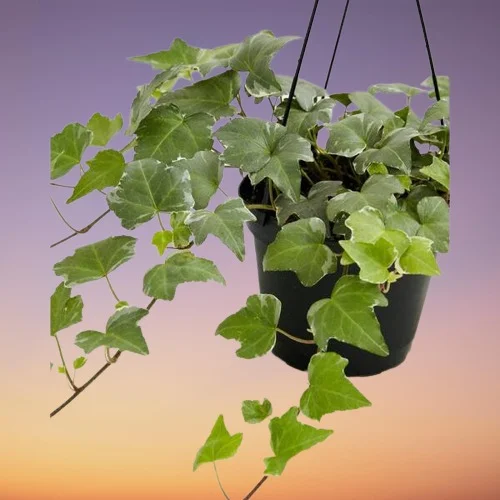
Botanical name: Hedera helix
Family: Araliaceae
Common names: English Ivy, Common Ivy, European Ivy
Origin
Hedera helix is native to most of Europe and Western Asia. In its native habitat, it is a rampant clinging evergreen vine found in gardens, waste spaces, on walls, tree trunks and in wild areas.
Varieties
The general form of English Ivy is the characteristically lobed leaves. There are many variations on the basic pattern. The leaf edges are smooth or ruffled and colors vary from simple green to complex mixtures of white, cream, grey and yellow.
Air Purifying
According to the NASA Clean Air Study, Hedera helix was found to be among the best air-cleaning plants and gets rid of benzene, formaldehyde, xylene, toulene and trichloroethylene from indoor air which qualifies this plant among the best plants for a study table for boosting concentration and productivity.
Invasiveness
One drawback of Hedera helix is that it can be invasive in some regions. Due to its aggressive nature, growing at a rate of 50-70 cm per year, it can choke out some native species. Take caution when growing this plant and find out if it is acceptable in your region.
Is Hedera helix poisonous to humans?
Yes. Hedera helix is toxic to both humans and pets as indicated by ASPCA. If ingested, it can cause vomiting, diarrhea and abdominal pains. Keep English Ivy away from the reach of children, cats, dogs and other pets.
Where to Buy
English Ivy are charming plants to add to your collection. You may obtain these plants online from Amazon (Link to Amazon).
How do you care for Hedera helix indoors?
Caring for Hedera helix indoors involves providing bright indirect light, average warmth of 16-260C, moderate humidity of 50-55% and moderately moist, fertile, well-drained soils coupled with monthly feeding during the growing season.
English Ivy care requires regular pruning to keep it neat, to encourage a bushy growth as well as discourage pests infestation. Repotting is necessary every two years or when it has become root-bound. Keep reading for more on these growing conditions and how to provide them.
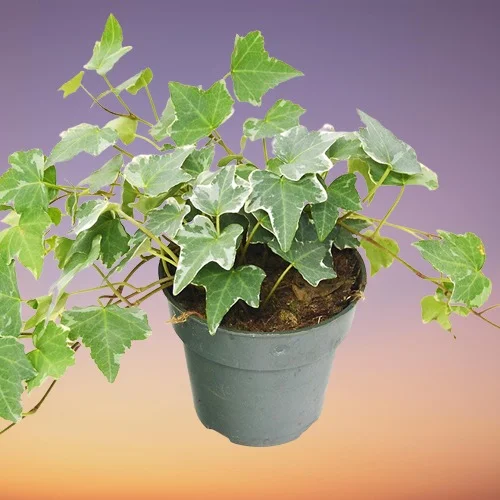
Watering
How often should I water Hedera helix?
Do not water Hedera helix on a schedule to avoid either overwatering or underwatering as both are detrimental to the growth of the plant.
Water your Hedera helix thoroughly in spring and summer while allowing the top 2 inches of soil to dry a little between waterings. Keep the soil moderately moist and avoid soggy soil to prevent yellowing and leaf drop.
Decrease watering in fall and winter as growth is minimal at this time. Do not allow the soil to dry out completely to avoid wilting and leaf fall.
Do not allow the plant to sit in soggy soil as it can lead to rotting and death of the plant. Therefore, use a pot that has a drainage hole and well-draining soil.
Light Requirements
Does Hedera helix need sunlight?
Hedera helix prefers bright indirect light. Put it infront of a large, brightly lit window. Keep it away from direct sunlight as it may cause scorching of the leaves.
English Ivy can tolerate lower light but too little light will result in leggy growth and loss of leaf color. Where natural lighting is not adequate you may use grow lights to supplement it.
Rotate the pot regularly to ensure that the plant receives light on all sides for even growth as well as prevent leggy growth.
Temperature and Humidity
Hedera helix flourishes in an average temperature of 16-260C. Keep it away from drafts to avoid temperature flactuations. Though it can adapt to a wide range of temperatures, constantly high temperatures can damage the plant and cause its death.
English Ivy has no need for extra humidity, moderate room humidity of 50-55% is sufficient for this plant. However, for lush growth and to reduce pest infestation, set the pot on a wet pebble tray or use a humidifier to raise humidity. Maintain good air circulation to minimize fungal diseases.
Potting Soil
The best soil for English Ivy is a well-draining, slightly acidic to neutral soil (pH 5.5-7.0). A blend of potting soil, perlite, and peat moss is ideal for the plant.
Fertilizer
What is the best fertilizer for Hedera helix?
Feed your Hedera helix with a balanced, water-soluble fertilizer every 4 weeks in spring and summer for a lush growth. Avoid too much fertilizer as it can cause leggy growth.
Stop feeding in fall and winter as growth is reduced at this time therefore the plant does not need it. Feeding at this time can result in fertilizer burn and death of the plant.
Repotting
Repot your English Ivy every 2 years during the growing period or when it is pot-bound. Do not allow it to become extremely root-bound to avoid wilting and leaf drop. Once you spot roots growing through the drainage hole, it is time to repot.
Use a pot that is 1 size larger than the current one. Make sure that the pot has a drainage hole and the soil is well-draining to prevent root-rot.
Hedera helix is perfect in a hanging basket where the the stems can cascade downwards beautifully. Take a look at these hanging planters on Amazon.
Pruning & Grooming
Pruning Hedera helix involves:
- Removal of yellow and dead leaves to maintain the plant neat as well as discourage pest infestations.
- Pinching off the growing tips to encourage a bushy and compact growth. The tips can be used to propagate new plants.
- Cutting back the leggy stems at the beginning of the growing season (spring) to rejuvenate growth.
Occasionally clean the leaves under a stream of running water to get rid of dust as well as discourage pest and infestations.
Hedera helix Propagation
Hedera helix (English Ivy) is propagated at the beginning of the growing season (spring to early summer) from stem cuttings or by plant division. The stem cuttings root easily so there is no need for rooting hormone. Rooting of the cuttings can be done in 3 ways.
Learn how to propagate Hedera helix (English Ivy) in 4 easy ways.
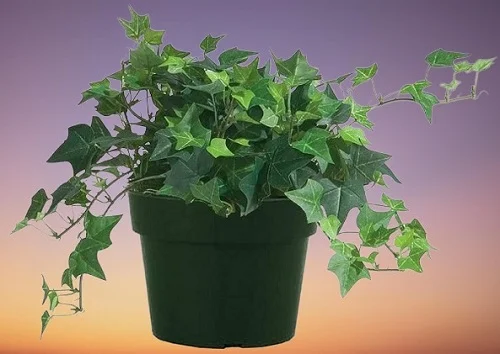
Hedera helix Problems & their Solutions
English Ivy (Hedera helix) problems are yellow leaves, wilting leaves, leggy growth, brown leaf tips, loss of variegation, pests and diseases among others. Keep reading for more on these problems and how to fix them.
Yellow leaves
Why are my Hedera helix leaves turning yellow?
The main causes of yellow leaves on your Hedera helix are overwatering, soggy soil, temperature stress, and aging.
How to fix it
Overwatering: Do not water on a schedule. Water only when the top 2-3 inches of soil dry out.
Soggy soil: Use a well-draining soil and a pot that has a drainage hole.
Temperature stress: Keep the plant away from drafts emanating from AC units, heat sources, windy doors, drafty windows and others.
Aging: As the plant matures, the leaves at the base turn yellow and fall off. Cutback the bare stems to rejuvenate growth.
Wilting leaves
Why is my Hedera helix wilting?
Your Hedera helix is wilting due to underwatering, hot drafts, being pot-bound, spider mite infestation, and direct sunlight.
How to fix it
Underwatering: Water when the top 2-3 inches of soil feel dry but do not allow the soil to dry out completely.
Hot drafts: Keep the plant away from stoves, heat vents and other heat sources.
Being pot-bound: Repot the plant every two years or when root-bound into a pot one size larger than the current one.
Spider mite infestation: Regularly check underneath the leaves for these pests and carry out timely control measures. Increase humidity and keep the plant well pruned to discourage the pests.
Direct sunlight: Keep the plant away from direct sunlight or use a sheer curtain to filter the sunlight.
Leggy growth
Leggy growth in English Ivy is caused by too little light, overfertilizing and lack of pruning.
How to fix it
Too little light: Move the plant to a brighter spot or instal a grow light if the natural light is not sufficient.
Overfertilizing: Feed monthly in spring and summer only.
Lack of pruning: Pinch off the growing tips regularly and cut back the leggy stems in spring to encourage a bushy growth.
Brown leaf tips
Brown, dry leaf tips on English Ivy are caused by dry air, extreme temperatures and underwatering.
How to fix it
Dry air: Set the pot on a wet pebble tray or use a humidifier to elevate humidity.
Extreme temperatures: Keep the plant away from drafts to avoid drastic temperature flacuations.
Underwatering: Water when the top 2-3 inches of soil dry out but do not allow the soil to dry out completely.
Loss of variegation
Loss of variegation in variegated English Ivy causing it to turn all green is caused by too little light and being pot-bound.
How to fix it
Too little light: Move the plant to a brighter spot where it will get bright indirect light or instal a grow light if the natural light is not sufficient.
Being pot-bound: Repot the plant into a pot one size larger than the current one and ensure it has a drainage hole to prevent rotting.
Pests
What are the pests for Hedera helix?
Common pests for Hedera helix are spider mites, mealybugs, scales, and aphids which are prevalent in dry conditions.
How to fix it
- Isolate the affected plant to prevent spread to the other plants.
- Treat the infested plant with neem oil or insecticidal soap as directed by the manufacturers.
- Regularly wash the leaves by splashing a lot of water on the leaves to keep the pests away.
- Use a humidifier or a wet pebble tray to raise humidity to discourage the pests.
- Keep the plant well pruned to reduce the hiding and breeding places for these pests.
Diseases
Common diseases in English Ivy are leaf spot and root-rot which are common in overwet (damp) conditions.
How to fix it
Leaf spot disease: The disease is prevalent in warm, humid conditions. It presents as dark-brown or black leaf spots.
- Remove and burn the affected parts to reduce the risk of spread to the rest of the plants.
- Spray the affected plant with a systemic fungicide and ensure to cover all the parts with the fungicidal solution.
- Keep the plant on the dry side, do not mist it and ensure good air flow.
- Use a pot with a drainage hole and well-drained soil.
Root-rot: The disease is promoted by soggy soil. It is characterized by yellowing and wilting of the leaves which is rapidly followed by browning and plant collapse.
- Carefully slip the plant out of its pot and inspect the roots.
- Trim brown-black mushy roots and treat the healthy roots with a copper-based fungicidal solution as indicated on the label.
- Disinfect the pot with the fungicidal solution or use a fresh pot to repot the plant in fresh, well-draining soil.
- Do not water the plant immediately; keep it dry for 5-7 days before you resume watering.
- Use a pot with a drainage hole and well-draining soil to prevent the soil from getting soggy.
- Reduce watering in fall and winter to keep the soil slightly moist as growth is slowed at this time.
Conclusion
Hedera helix is a timeless and versatile plant that thrives indoors with minimal care. By providing bright indirect light, proper watering, and occasional pruning, you can maintain lush, trailing vines year-round. Whether you grow it in hanging baskets or as a climbing vine, English Ivy enhances any indoor space while offering air-purifying benefits
You liked it? Share on social media.
Related Content
Amazon Associates Disclosure
Homeplantsguide.com is a participant in the Amazon Services LLC Associates Program, an affiliate advertising program designed to provide a means for sites to earn advertising fees by advertising and linking to amazon.com.



